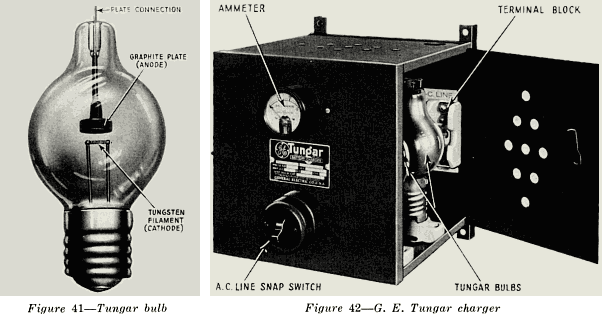If one tube such as described above (see Figure 41) is connected to change an
alternating current to direct current, the circuit is known as a half-wave rectifier
because direct current flows during one-half of the cycle. During the other halfcycle (when the plate of the tube is negative) no current will flow. When two rectifier tubes are used with the proper circuit it is possible to cause direct current to flow
in the load circuit for the entire cycle. Such an arrangement is known as a fullwave rectifier.
57. Description of Operation of Tungar and Rectigon Chargers. -The Tungar
and Rectigon battery chargers are alike in principle. Figure 42 is a picture of a
Tungar which is simple in construction and operation, and will be described in
detail. Figure 43 is a schematic circuit diagram of this Tungar. The device consists of a transformer, two Tungar bulbs, an ammeter, and a line switch all
mounted in a sheet-iron case.

Referring to Figure 43, it will be noticed that an alternating current will
flow in the primary of the transformer when the line switch is closed. A voltage will
be generated in the secondary winding by transformer action. The secondary winding is tapped a few turns from each end to provide a voltage for lighting the filaments of the Tungar bulbs. These filaments are lighted in the same manner as an
ordinary electric light except that it uses a very low voltage. (Two and one-half
volts are used for lighting the Tungar filament.) The purpose of lighting the filament is to cause it to emit a large number of electrons. The secondary of the
transformer is also tapped at its mid-point, and a connection is made from this
tap to the positive side of the storage battery being charged. The plates of the
two Tungar bulbs are wired together, and are connected, through the ammeter, to
the negative side of the storage battery.
5
